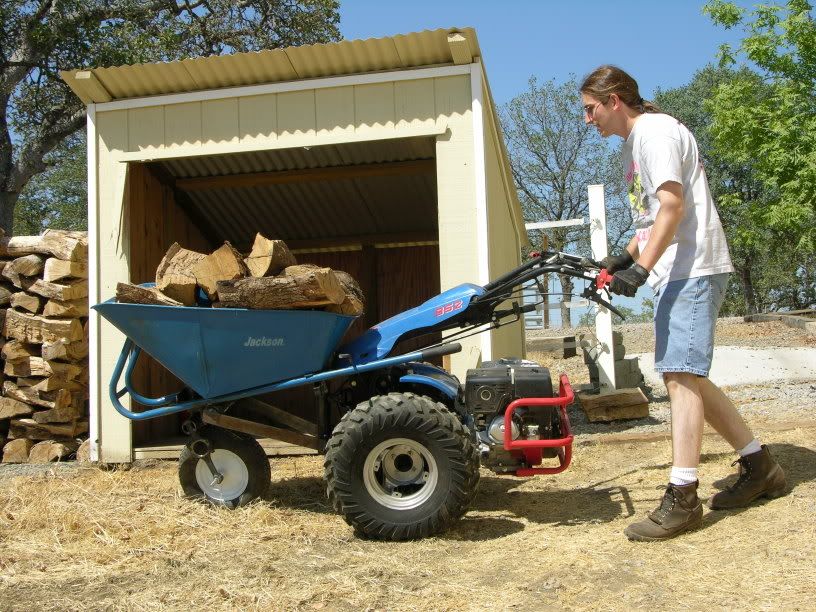andyfletcher
Bronze Member
- Joined
- Mar 16, 2004
- Messages
- 65
(*TM Dr. Powerwagon, DR Lawn Equipment)
http://www.ruralcompanion.com/powerwagon.html
Looking at this handy little worker, it would be great to have
around. I use a wheelbarrow a lot and occasionally need to move leaves and dirt around the garden.
I was thinking around a square frame made of angle that is boxed and welded together. A wooden box would fit on that hinged and backward balanced so that it dumps on gravity alone. Angle should be light enough as it's 3/32 steel. I'd put 20" turf tires with deep lugs on it on 1in axles. My Craftsman snow blower conked out yesterday from a busted axle after 25 years of service and several repairs, but the 8HP engine is in top shape.
The drive axle I'd make in split fashion, one side driving each wheel, and supported by pillow block bearings, 2 per axle.
On each axle I'll put a large 12in pulley and that would be belted down to a 2inch or so pulley for each axle. Size depends on RPM. I'd be striving for the equivalent 1,2 and 3rd drive RPM's on my blower which has 6 forward speeds. I'd leave out the 4,5,6 speeds which will make the machine slow with fewer speed options, but will save me on drive pulleys, as I will need to gang them on a seperate clutch shaft from the motor. Engagement is the usual idler pulley that slides along a square shaft.
The power concept would work like an armored personell carrier, if any of you guys remember them. Pulling both sticks engages both drive axles evenly. Pulling one, drives one more than the other making it steer, so there's alot of friction involved and means more belt replacements. Pulling the stick pressess an idler wheel against the belt of that particular wheel making friction contact in the V pulley. I'm goint to try to find the wider belts and pulleys of 3/4in for the drive mechanism.
I was figuring a rear 2 wheel idler axle with a seat, but then with a 600lb payload and a person added, the 8HP will have a really heavy job of it unless I would really need to gear the drive setup down, so I guess it will be the tricycle with swivel bogey wheel and walk behind type arrangement like the Dr. But I think stability will suffer and side hills will be nerve wracking. with this arrangement. A larger engine would be better, but I'll need to use what I got, sides, the Dr. uses a 6.5.
Whadya think?
Fletch
http://www.ruralcompanion.com/powerwagon.html
Looking at this handy little worker, it would be great to have
around. I use a wheelbarrow a lot and occasionally need to move leaves and dirt around the garden.
I was thinking around a square frame made of angle that is boxed and welded together. A wooden box would fit on that hinged and backward balanced so that it dumps on gravity alone. Angle should be light enough as it's 3/32 steel. I'd put 20" turf tires with deep lugs on it on 1in axles. My Craftsman snow blower conked out yesterday from a busted axle after 25 years of service and several repairs, but the 8HP engine is in top shape.
The drive axle I'd make in split fashion, one side driving each wheel, and supported by pillow block bearings, 2 per axle.
On each axle I'll put a large 12in pulley and that would be belted down to a 2inch or so pulley for each axle. Size depends on RPM. I'd be striving for the equivalent 1,2 and 3rd drive RPM's on my blower which has 6 forward speeds. I'd leave out the 4,5,6 speeds which will make the machine slow with fewer speed options, but will save me on drive pulleys, as I will need to gang them on a seperate clutch shaft from the motor. Engagement is the usual idler pulley that slides along a square shaft.
The power concept would work like an armored personell carrier, if any of you guys remember them. Pulling both sticks engages both drive axles evenly. Pulling one, drives one more than the other making it steer, so there's alot of friction involved and means more belt replacements. Pulling the stick pressess an idler wheel against the belt of that particular wheel making friction contact in the V pulley. I'm goint to try to find the wider belts and pulleys of 3/4in for the drive mechanism.
I was figuring a rear 2 wheel idler axle with a seat, but then with a 600lb payload and a person added, the 8HP will have a really heavy job of it unless I would really need to gear the drive setup down, so I guess it will be the tricycle with swivel bogey wheel and walk behind type arrangement like the Dr. But I think stability will suffer and side hills will be nerve wracking. with this arrangement. A larger engine would be better, but I'll need to use what I got, sides, the Dr. uses a 6.5.
Whadya think?
Fletch

